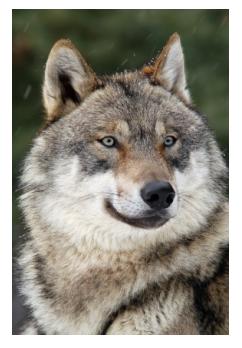
The Ministry of Natural Resources estimates that there are between 8,000 and 10,000 wolves in the province. This estimation was made over 40 years ago and has remained unchanged. However no reliable survey method has been employed. (!)
There are two wolf species in Ontario: the Gray wolf (Canis lupus) and the Eastern wolf (Canis lycaon) which is also known as the Algonquin wolf because of its declining yet popular presence in Algonquin Provincial Park. The Ministry of Natural Resources implemented a permanent ban on hunting and trapping wolves and coyotes in 40 townships surrounding the park last spring in an attempt to curb the park's population decline. The Eastern wolf has been added to both the National and Provincial Species at Risk lists as a species of “Special Concern”.
Although wolves are Canadian animals, according to the Ontario authorities, "there are no Wolves in Ontario, south of the city of Barrie".(!!)
However, I wouldn't be surprised if a few individuals or small packs of Wolves have made their way into this area recently.
According to the site Wolves-Ontario.com, there has only been one documented case of healthy wild wolves killing a human in North America.
It is believed that these animals had lost their fear of humans and were accustomized to them.
By comparison, domestic dogs attack 3 million and kill 20 people each year.
Wild, non-socialized, wolves fear humans and are rarely seen.
More Wolf Facts
Wolves are intelligent and social animals.
They have complex social families; they play, teach, and hunt with each other.
Radio collared wolves have been tracked ranging more than 700 kilometres.
A wolf’s sense of smell is 100 times more sensitive than a human’s.
R.D. Lawrence wrote that a "five month old [wolf pup] was able to pick up the smell of a porcupine eating grass in a meadow a mile [1.6 kilometres] from the pup."
Noted wolf biologist, L.D. Mech stated that "wolves can hear as far as 6 miles [9.6 kilometres] away in the forest and ten miles [16 kilometres] away on the open tundra.
Wolves have been known to respond to human imitations of wolf howls from 4 kilometres away.
Wolves in Ontario tend to be between sixty pounds (27 kg) and one hundred pounds (45 kg) with the heavier wolves ranging in the north of the province.
The heaviest wolf on record in Canada was found in 1945 in Jasper National Park. He weighed 175 pounds (80kg).
Wolves’ fur ranges in colour from gray brown to white to black.
The tip of a wolf’s tail is often coloured black.
"You never see them. I work out in the bush all the time and normally your first glance is your last glance," he says.
How my dog and I encounterd 4 of the above, and walked out of there, is beyond me 24 hours after our experience.
2 comments:
Lucky you to encounter some of the most magnificent and noble creatures on Earth… I’ve been looking for wolves in the forest since childhood…
Of all the things I felt at the time, luck was not one of them.
But I understand your position.
Post a Comment